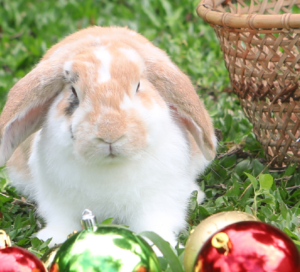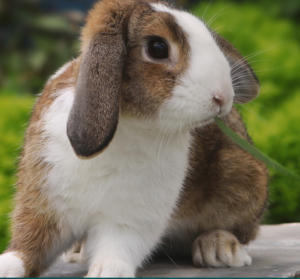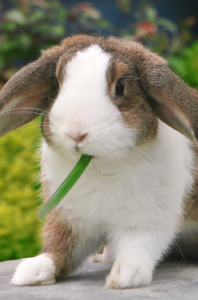Rabbits are simply adorable. They’re often one of the first choices for children’s pets. They’ve also been hugely popular in literature, film and TV, from ‘The Velveteen Rabbit’ to the White Rabbit from ‘Alice’s Adventures in Wonderland,’ from “The Tortoise and the Hare’ to Bugs Bunny.
Rabbits have the scientific name Oryctolagus cuniculus. They are the only species in that genus, but there are over eighty varieties of rabbit! They come in various colors, sizes and breeds. Even their ears have different shapes and sizes.
Among the most popular rabbit breeds in the world are lop-eared rabbits.
A ‘lop’ is a rabbit whose ears hang down the side of its head instead of pointing upwards. There are approximately 19 different breeds of lops, such as English lops, Cashmere lops, Lionhead, and Dwarf Lorraine lops.
Two of the most popular lop breeds are the French lop and the Holland or Dutch lop. Animal Scene presents the basics on these adorable varieties.
The French Lop

Alfie of RHQ or Rabbit Headquarters is a rabbit breeder based in Singapore who generously shared his experience as a breeder of the French lop with Animal Scene. “The French Lop was born from a selective breeding program between an English lop and a Flemish Giant. The result is a large muscular lop-eared rabbit that can grow to the size of a dog,” he explains.
As the name suggests, the breed originated in France in the mid-1800s. One of the French lop’s identifying characteristics is its huge size, such that it’s considered a “giant” breed. It
can grow up to 13 pounds. According to PetPlanet.co.uk, “These rabbits are very heavy and cobby with wide, bold heads. Their ears are between 30 to 38 centimeters (cms) long (measured from the tip of one ear to the tip of the other ear), making them considerably shorter than those of the English Lop. The French Lop comes in a variety of colours including agouti, black, broken marked, chinchilla and sooty-fawn.”
This giant rabbit breed is known for its sweet disposition. Alfie says, “They are generally very sociable and have a sweet temperament, which is the main reason for its popularity with kids. They are commonly known for being very docile. They are sociable and playful, sometimes lazy, often very affectionate. It’s very easy to play and bond with them on a daily basics, as all rabbit owners should.”
Unfortunately, they’re also a little sensitive. Those who want to add a French lop to their family may have to take some extra care. Alfie cautions, “Generally the bigger breeds of
rabbits are more sensitive to their surroundings. They require more time to adjust to new environment as compared to other breeds. It would be best to have an enclosure that’s approximately of 2 meters by 1 meter, so they have room to play and explore. Once they are toilet-trained, they [can] be let out to roam your house or apartment.”
If you’re sure about getting a French lop, make sure to prepare your home for his arrival. You will need a “…cage, a tray for waste, water bottles, and a food bowl. This is the basic setup for your pet rabbit.”
What does such a big bunny eat? “You can feed them varieties of supplements and hay. Their diet is similar to a normal rabbit. But stuff like carrots should be fed to them sparingly, as it is too sweet for them.”

How do you know when a French lop is healthy? “A healthy rabbit is usually alert to its surrounding and is eating and drinking well,” Alfie says, and shares some things to watch out
for. “You should be concerned if their appetite drops, or the size or quantity of their feces decreases. Rabbits are sensitive animals, and they should be rushed to a vet immediately if such symptoms appear.”
What else should you watch out for? “Always make it a point to check on their food intake and waste. When there is a sudden decrease in food intake, it could indicate discomfort in their teeth or even their bowel movement, which could be critical for them. A significant reduction in the fecal matter they produce is the result of GI (gastrointestinal stasis). Feed your rabbit more timothy hay, as the long fiber in it helps to keep the gut moving.”
The Holland Lop

Most breeders work with different breeds of rabbits, and Alfie also breeds Holland lops. He pointed out the main difference between this and the French lop: “The most obvious difference
would be their size and body type.
Holland is a compact breed, whereas the French lop is more popular commercially. The Holland lop is structurally compact and upright, while the French lop has a well-muscled, meaty body. Holland is basically a dwarf version of the French, but the French an older and more
established breed. The Holland lop is the work of selective breeding between French Lops and Netherland Dwarfs. The Holland lop is the smallest lop-eared rabbit breed in the world.
Archie Uy is a local a rabbit breeder who breeds Holland lops. He explains the fascination. “For me, as a hobbyist, the cuter it looks, the more fascinated I am.” Alfie shares the sentiment: “The Holland lop is the perfect combination of a masculine stocky body with an
adorable face. The lop ears paired with the chubby adorable cheeks tend to melt hearts, and their sweet temperament only makes them irresistible.”
Holland lops are usually fed pellets, timothy hay, and regular supplements. Alfie advises, “A diet of nourishing pellets and variety of hay should be a stable diet choice for them. Occasionally some might add greens to their diet. However, iceberg lettuce should be avoided, as it contains high water content and is low in nutrients. It could cause diarrhea or GI stasis, which is deadly.”
Like the French lop, the Holland lop is a friendly rabbit. Alfie says, “Holland lops are more docile and relaxed. It’s recommended to handle them more often so that they are used to their owners. It’s a recommended pet for both children and adults.” Archie agrees: “The Holland lop is okay for children to take care of. It’s easy to handle, groom, and feed it. Even if the lop is still young, you can interact with them and tame them easily.”

What kind of home should you prepare for your Holland lop? Archie recommends, “A cage that is around 2 feet by 2 feet should work. It’s best if the cage has three levels, so they can
exercise and move around. Water is also very important. Don’t buy cheap bottles because they tend to leak. Rabbits need water all the time; otherwise, they get dehydrated easily.” In addition, he suggests the following accessories: a tray to go with the cage; food containers;
food in the form of pellets, mixed vegetables and leaves of corn; and a wooden tunnel or an edible toy. You can also get a hay rack, pee spray for toilet training use, and dietary supplements.
More is not always merrier. Archie advises, “Each cage should have only one rabbit. Two males in one cage often result in injuries, especially in the genitalia. Two females in the same cage often result in wounds in the ears.
”What about Holland lops rooming in with other breeds? Archie says, “Different breeds can definitely co-exist in the same enclosure, with absolutely no problem. However, breeding them should be avoided at all costs. The resulting offspring will be a wrong representation of either breed, and usually, they look nothing like the parents.”
Like all pets, Holland lops get sick too. Archie says you should watch out for “how they eat. Rabbits are like goats: they eat and eat nonstop! So if you give them food and they snub it, that’s a sign the animal is not feeling well.” Sometimes they also have skin problems, and the usual colds. But the number one cause of death among Holland lops? Diarrhea. Be very careful when it appears!
The Choice is Yours
For many people, choosing a pet is more of an emotional decision. They look for an animal that seems to like them, or responds to them. How do you know if the French lop likes you? “Does the animal warm up to you when you interacting with it? Sniffing you or even a lick on your hand could signal curiosity about you. These are positive signs to look out for,” says Alfie.
Where the French lop is gigantic, the Holland lop is miniscule. Their standard weight is 1.5 to 2 kilograms (3 to 4.5 pounds). According to hollandlopbunny.com, “The Holland Lop bunny is the smallest of the lop breeds. To differentiate Holland lops from the other lop eared breeds, Holland lop bunnies have a more apple shaped head than French or Mini Lops. Additionally, the Holland Lop bunny has shorter ears with lengths approximately 11-12 inches from tip to tip.
A Holland Lop can be broken into two varieties: Solid (or self) and Broken colors (colors interrupted by white).”
Advice for First-Time Rabbit Owners
Some people are more interested in keeping a rabbit rather than a cat or a dog. If you’re getting a rabbit for the first time, here’s what you should know.
1. According to Archie, the important thing is their food. Adult rabbits can have vegetables, but both adults and bunnies can consume pellets. As they mature, you need to gradually
change their diet. Overall, their diet should be rich in fiber.
2. How do you get a rabbit to like you? Archie suggests treats, such as hay, banana leaf (very rich in fiber), kamote leaves, cinnamon sticks, and apple sticks.
3. Rabbits have soft fur coats, so it’s important to brush their fur regularly. Rabbits lick themselves to groom, and an excess of loose fur may result in a hairball, which could block the intestines.
4. Because your rabbit licks itself clean, you don’t really need to give it a bath. But sometimes it can’t properly groom itself, and might need some help. You can lend a hand by gently wiping its soiled parts. If that’s not enough, a full bath might be in order. You can use pet shampoo with warm water, but make sure to avoid the rabbit’s sensitive eyes and ears. After rinsing, immediately dry her off with clean, dry towels.
5. You can give your rabbit a pedicure! It helps to trim your rabbit’s nails to ensure it can hop properly, and its nails won’t snag or get ripped off. But don’t trim too much, or you
might hit a blood vessel! According to hollandlopbunny.com, “Rabbits have five (5) nails on their front feet and four (4) nails on their back feet.”
6. Never pick up a rabbit by its ears!
7. If your rabbit thrashes violently about when you pick it up, it might break its back! If it’s startled when picked up, it might think it’s been picked up by a bird to be dinner. Pick up your rabbit by putting one hand under its chest and raise it upward as in a standing position. Then use your other hand to support its butt. You can use your own chest as additional support for it to rest against.
8. The saying “breed like rabbits” is no joke. They reach sexual maturity as young as three months old! So unless you want to be a breeder, spay or neuter your rabbit. This has other health benefits too. Females will have lower risk of uterine cancer. Males will be less
territorial. And they will be easier to litter train.
9. Rabbits tend to eat and poop at the same time! It’s a good idea to keep the litter box near the food dish.
10. Just like a dog, you can put a leash on your rabbit and go for a walk. Rabbits are wonderful animals, and can make great pets, no matter how old you are.
This appeared in Animal Scene’s December 2015 issue.






